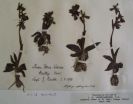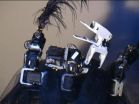Adverse cardiac events are rare after a negative cardiac CTA exam, study suggests
2010-09-22
(Press-News.org) Adverse cardiac events are rare one year after patients are admitted to the emergency room with low-to-moderate risk chest pain and are discharged due to a negative cardiac computed tomography angiogram (CTA), according to a study in the October issue of the American Journal of Roentgenology (www.ajronline.org). Cardiac CTA is a noninvasive heart-imaging test that determines whether fatty deposits or calcium deposits have built up in the coronary arteries that supply blood to the heart muscle.
Earlier discharge of patients with low-to-moderate risk chest pain after negative initial testing and a cardiac CTA scan without significant coronary artery disease (CAD) may result in substantial savings in both cost and time in the emergency department, and may help alleviate emergency department congestion. With growing awareness of such cost and time savings, emergency department practice is gradually trending toward the use of early cardiac CTA in some centers.
The study, performed at the University of Washington School of Medicine in Seattle, WA, included 70 patients with negative cardiac CTA results who were interviewed in detail at 3, 6 and 12 months about intervening cardiac events, diagnostic testing and therapy. "No patient reported any sign, symptom, finding or subsequent diagnosis suggestive of an adverse cardiac event, nor was there any such suggestion in the electronic medical record," said William P. Shuman, MD, lead author of the study.
"For earlier discharge based, in part, on negative cardiac CTA results to be clinically efficacious, it must be a safe practice with few subsequent adverse cardiac events," said Shuman.
"Our study shows that for patients with low-to-moderate risk chest pain evaluated in the emergency department, adverse cardiac events may be rare during the year after a negative cardiac CTA scan," he said.
###This study appears in the Oct. issue of the American Journal of Roentgenology. For a copy of the full study or to request an interview with Dr. Shuman, please contact Heather Curry via email at hcurry@acr-arrs.org or at 703-390-9822.
About ARRS
The American Roentgen Ray Society (ARRS) was founded in 1900 and is the oldest radiology society in the United States. Its monthly journal, the American Journal of Roentgenology, began publication in 1906. Radiologists from all over the world attend the ARRS annual meeting to participate in instructional courses, scientific paper presentations and scientific and commercial exhibits related to the field of radiology. The Society is named after the first Nobel Laureate in Physics, Wilhelm Röentgen, who discovered the x-ray in 1895.
END
ELSE PRESS RELEASES FROM THIS DATE:
2010-09-22
The growing use of rapid response teams dispatched by hospitals to evaluate patients whose conditions have suddenly deteriorated may be masking systemic problems in how hospitals care for their sickest patients, says a prominent Johns Hopkins patient safety expert.
In a commentary published in the Sept. 22 issue of the Journal of the American Medical Association, Peter Pronovost, M.D., Ph.D., a professor of anesthesiology and critical care medicine at the Johns Hopkins University School of Medicine, and co-author Eugene Litvak, Ph.D., president of the Institute for Healthcare ...
2010-09-22
Plants picked up to 150 years ago by Victorian collectors and held by the million in herbarium collections across the world could become a powerful – and much needed – new source of data for studying climate change, according to research published this week in the British Ecological Society's Journal of Ecology.
The scarcity of reliable long-term data on phenology – the study of natural climate-driven events such as the timing of trees coming into leaf or plants flowering each spring – has hindered scientists' understanding of how species respond to climate change.
But ...
2010-09-22
Washington, D.C. (September 21, 2010) -- Laser ablation is well known in medical applications like dermatology and dentistry, and for more than a decade it has been used to vaporize materials that are difficult to evaporate for high-tech applications like deposition of superconductors. Now researchers in the Journal of Applied Physics, which is published by the American Institute of Physics have studied the properties of femtosecond laser ablation plumes to better understand how to apply them to specialized films.
Salvatore Amoruso at University of Naples, Italy and ...
2010-09-22
Washington, D.C. (September 21, 2010) -- For months, Anthony West could hardly believe what he and his colleagues were seeing in the lab -- or the only explanation for the unexpected phenomena that seemed to make sense.
Several of the slightly doped high-purity barium titanate (BT) ceramics his research group was investigating were not following the venerable Ohm's Law, which relates electrical voltage to current and resistance. Applying or removing a voltage caused a gradual change in the materials' electrical resistance. The new effect was seen consistently regardless ...
2010-09-22
Washington, D.C. (September 21, 2010) -- Research is closing in on the next-generation of ultra-high-density magneto-optical storage devices that could store more than 6,000 Terabits (6 petabits) of data, more than 70 times the contents of the entire U.S. Library of Congress, on a single 5-inch disc. Yet the vast storage amount is limited by the ability to write data quickly enough to the device. In the Journal of Applied Physics, researchers at Sun Yat-Sen University in China have demonstrated a way to record on ferromagnetic films using a laser-assisted ultrafast magnetization ...
2010-09-22
Washington, D.C. (September 21, 2010) -- At its most basic level, understanding chemistry means understanding what electrons are doing. Research published in The Journal of Chemical Physics not only maps the movement of electrons in real time but also observes a concerted electron and proton transfer that is quite different from any previously known phase transitions in the model crystal, ammonium sulfate. By extending X-ray powder diffraction into the femtosecond realm, the researchers were able to map the relocation of charges in the ammonium sulfate crystal after they ...
2010-09-22
COLUMBUS, Ohio – Patients who experience physical or psychological stress – including rigorous exercise – one or two days before a cancer treatment might be unknowingly sabotaging their therapy, new research suggests.
Stress in the body – even physical stress caused by intense exercise – activates a stress-sensitive protein that can spark a series of events that allow cancer cells to survive such treatments as chemotherapy and radiation, according to the research.
Though the study involved a series of experiments in breast cancer cell cultures, the researchers say ...
2010-09-22
Broca's region is classically regarded as the motor centre for speech. Our ability to form phonemes and words is controlled here. According to the maps of the cerebral cortex developed by Korbinian Brodmann, which are still in use today, Broca's region is composed of two areas. Over the last few years, however, researchers have begun to question this subdivision as a result of experience gained in clinical studies and the findings of magnetic resonance imaging analyses. "Lesions in Broca's region could result in a dozen different language problems," says Professor Katrin ...
2010-09-22
For advanced activities of our daily life (such as driving a car, or seeing a movie), to be awake is important. It has been known so far that neuropeptide in the brain called "Orexin"controls sleep and awakening besides appetite. Here, the research group led by Dr. Akihiro Yamanaka, National Institute for Physiological Sciences (NIPS), found that orexin-releasing neurons have the self-excitation mechanism that activate each other among them, and maintain awaking. From this result, the application to doze prevention or insomnia treatment can be expected. It is reported in ...
2010-09-22
The Dying Swan is sometimes moving smoothly and gently, sometimes in a dramatic and fiery manner, as Tchaikovsky´s majestic music from the ballet Swan Lake is playing. Yet this is no ordinary ballet dancer, but a robot in the form of a swan, created at Mälardalen University and choreographed by professional dancer Åsa Unander-Scharin.
The swan robot´s just over four-minute-long dance has so far been seen only by a select few. But it has already made a big impression. Tearful eyes and words like "touching", "fascinating" and "beautiful" are some of the reactions.
- We ...
LAST 30 PRESS RELEASES:
[Press-News.org] Adverse cardiac events are rare after a negative cardiac CTA exam, study suggests

